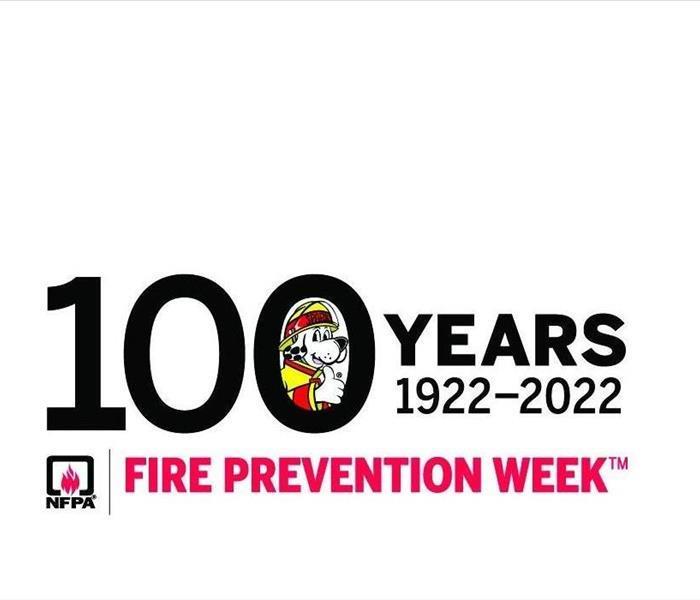Archived Fire Damage Blog Posts
Navigating Fire Emergencies With Confidence | SERVPRO of Carleton/Maybee
1/15/2025 (Permalink)
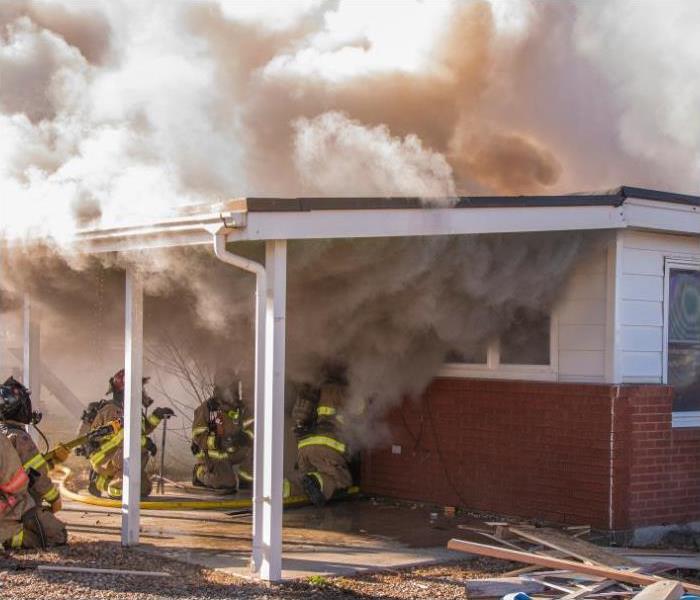 When the flames and smoke are gone, call SERVPRO of Carleton/Maybee to help return your home to it’s preloss condition.
When the flames and smoke are gone, call SERVPRO of Carleton/Maybee to help return your home to it’s preloss condition.
Experiencing a house fire can turn a homeowner’s world upside down. The inherent danger alone can evoke significant distress, not to mention the potential for extensive damage.
Unfortunately, house fires are common occurrences in the United States, and they can happen to anyone unexpectedly. Knowing how to evacuate your home quickly is essential.
Understanding the Onset
A house fire can be sparked by a number of things, such as a forgotten candle, a kitchen mishap or an uncontrolled grill fire. Once ignited, a fire can rapidly spread, devouring everything in its path.
Within just 30 seconds, a small flame can engulf walls, curtains, cabinets and other combustible materials. Within a minute, the room becomes filled with smoke.
In two minutes, thick smoke and flames can envelop the entire space, turning it pitch black and disorienting anyone inside.
Within five minutes, the fire can engulf the entire house, making escape incredibly challenging, if not impossible.
Tips for Safe Evacuation
Your family needs to have a fire escape plan in place and to practice it regularly. Here are the basics:
If you’re in the same room where a fire begins, exit immediately through the nearest door or window and call 911. If you must navigate through your home, stay close to the ground to avoid inhaling smoke and crawl if necessary for a safe exit.
How quickly you evacuate can mean the difference between safety and danger. Fire smoke contains harmful chemicals that can cause disorientation or drowsiness, particularly if trapped indoors. Crouch or crawl below the smoke line as you exit. Once outside, gather with your family at the designated meeting point and contact emergency services.
Recovery Process
Recovering from a house fire can be daunting, given the extensive damage it can cause. You’ll need to choose a reliable company to assist in the recovery and restoration of your home.
At SERVPRO of Carleton/Maybee, we specialize in fire damage restoration and are equipped to handle any level of damage. Our team efficiently removes debris and thoroughly cleans affected areas, eliminating smoke odors.
We can also handle rebuilding and reconstruction, even if it involves tearing down and rebuilding sections of your home. We will work to ensure complete restoration for you and your family.
We can help you recover faster after a house fire. Contact SERVPRO of Carleton/Maybee day or night.
SERVPRO’s Fire Damage Restoration Process | SERVPRO® of Carleton/Maybee
5/19/2023 (Permalink)
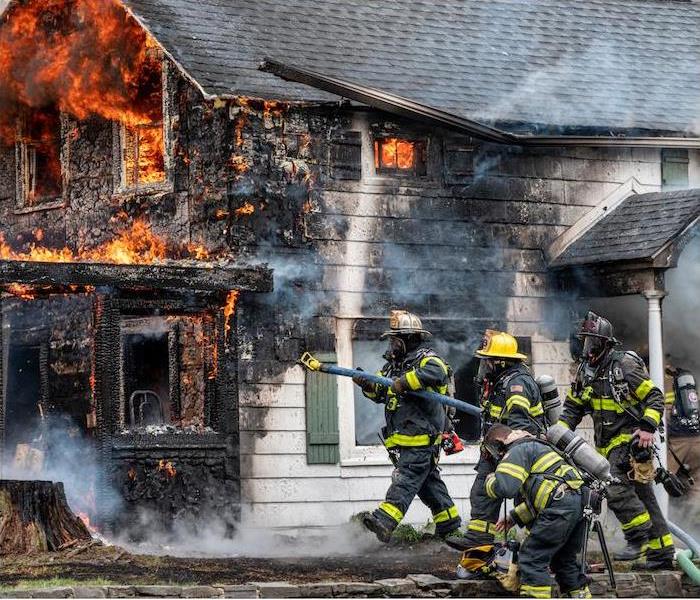 House fires are scary events. Call SERVPRO of Carleton/Maybee to help clean up the aftermath so you can focus on what matters most.
House fires are scary events. Call SERVPRO of Carleton/Maybee to help clean up the aftermath so you can focus on what matters most.
If you experience a house fire, there will be a lot of emotions running through your mind. From the initial shock of adrenaline to the stress of standing in your fire-damaged home, it can be overwhelming.
After the fire is out and you are left to figure out your recovery plan, remember that SERVPRO of Carleton/Maybee is here to help.
House fires can range from minor inconveniences to total devastation, but no matter the extent of the damages, our team can help you fully recover. We can jump right into action and begin the repair process so that you are displaced for as little time as possible.
The First Phone Call
Whether you give us a call in the afternoon or in the middle of the night, we will answer. We will start by asking all kinds of questions about the fire and your home to help us formulate our recovery plan. Different house styles and building materials can affect how we approach each situation, so we like to be as thorough as possible.
Once we have our initial ideas in place, we pack up our trucks and hit the road on our way to you. We will do a full walkthrough of your home and we will inspect the damage firsthand. Before we get started on any project, we will secure the rest of your home to prevent further damage by boarding up windows and laying tarps over your possessions.
The Debris Removal
Now that your home is secure, we can get to work! We will bring in advanced equipment to help us remove the damaged debris and soot buildup, and we can start drying out any standing water. Many homes also have water damage on top of fire damage due to the hoses used to put out the fire.
We will go around your home and remove smoke and soot residue from every room, even in spaces that weren’t touched by the fire.
Once the initial debris is gone, we will give your space a cleaning from top to bottom and sanitize everything that is able to be put back in its place in your home. We will bring in air scrubbers and fogging equipment for one final sweep to make sure everything is clean and ready to go.
The Restoration Process
The time has come! Restoring your home can include new drywall, flooring, carpet or entire rebuilds of rooms or sections of your home. We are detail-oriented enough to tackle even the most intricate of reconstruction projects, so you know you are in good hands.
Our SERVPRO of Carleton/Maybee team is locally owned and operated, but we are backed by a national brand that gives us unique connections to equipment and restoration materials. No matter how your fire started, our team is here to help 24/7.
House fires can cause widespread damage. Our fire damage restoration team can help.
Fire Prevention and Safety
9/2/2022 (Permalink)
Fire Prevention Week is October 9 - 15, and will be celebrating it’s 100th anniversary this year with a campaign theme of “Fire won't wait. Plan your escape™” (https://www.nfpa.org/fpw). During this annual event, the National Fire Protection Association provides resources and materials to educate the public about important actions that can be taken to prevent home fires and to keep their families safe from fires should they occur.
The NFPA estimates that a family may have as little as two minutes to safely escape a home fire after the smoke alarm goes off (https://www.nfpa.org/Events/Events/Fire-Prevention-Week/About). This makes it crucial for every household to establish a home fire escape plan, as well as a family home safety action plan that focuses on preventing fires from occurring in the first place, and detecting and reacting to them quickly if they do. The NFPA offers the following guidelines for fire safety:
Smoke alarms should be placed in every bedroom and hallway on each level of the home at a minimum. The only rooms smoke alarms are not recommended is in kitchens and bathrooms. They should be tested regularly by pushing the test button, as often as on a monthly basis. In between tests, if a detector begins chirping the batteries should be replaced immediately. For any smoke detectors that are over 10 years old, the whole unit should be replaced.
Home fire escape plans should be made to make sure that everybody knows what to do to get out safely if the smoke alarm goes off, or if someone smells smoke or sees flames. These plans should include a map of the home marking two ways out of each room (including windows and doors), escape routes, and an outside meeting place. Arrangements should also be made to assist young children, older adults, and people with disabilities to evacuate should a fire occur. Home fire drills should be practiced at least twice a year.
Some additional fire safety tips offered by the National Safety Council are as follows: (https://www.nsc.org/community-safety/safety-topics/emergency-preparedness/fire-safety)
- When cooking, stay in the kitchen. Keep anything that could catch on fire away from the stovetop. If baking, use a timer and check the food regularly.
- Do not leave space heaters or fireplaces unattended. Turn off heaters and make sure fireplace embers are extinguished before leaving the room. Keep all flammable items at least 3 feet away and keep children and pets away as well. Look for space heater models that shut off automatically when tipped over.
- When using a fire extinguisher, remember the acronym PASS: Pull the pin, Aim low at the base of the fire, Squeeze the handle slowly, and Sweep the nozzle side to side. Home fire extinguishers should only be used on small fires. If the fire has spread or there is a lot of smoke, you should call the fire department and evacuate as soon as possible.
If your family does suffer the unfortunate event of a home fire loss, SERVPRO of Carleton/Maybee is here to help. We have specialized fire restoration training to remove any water from firefighting efforts, dry remaining moisture with air movers and dehumidifiers, remove smoke and soot from walls and ceilings, and clean and sanitize all restorable items that were damaged by the fire. We will work with your insurance company to coordinate this process and direct you to reconstruction services for any repairs that may be needed. Call us in the event of a fire emergency at (734) 299-7006.
Reduce Your Risk of a Dryer Fire
7/19/2021 (Permalink)
According to the US Fire Administration, there are more than 2,500 clothes dryer fires in homes across the United States every year, causing an estimated 5 deaths, 100 injuries, and $35 million in property damages. As simple as it seems, the biggest contributing factor of these fires is failure to clean the lint screen.
To protect your home and family from such a tragic disaster, there are several safety tips you should follow to decrease your chances of dryer fire in your home.
- Have your dryer installed and serviced by a professional
- Follow the manufacturers operating instructions and do not try to over load your dryer
- Clean the lint screen before and after every load of laundry
- Do not use a dryer without a lint screen
- Be extra careful when drying clothes that have been soiled with flammable substances. If possible, wash clothing more than once and hang to dry
- Keep the area around your dryer clear of things that can burn
- Don’t forget to clean the back of the dryer where lint builds up and around the drum
- Make sure the venting system is not damaged or crushed which restricts air flow
- Check that the outdoor vent flap opens when the dryer is operating
- Once a year, or more often if you notice that it is taking longer for laundry to dry, clean out the vent pipe, or have a professional service do it for you
If you or someone you know has experienced a dryer fire, or any type of fire and need help, call the professionals at SERVPRO of Carleton/Maybee at (734) 299-7006.
Turkey Deep Frying Tips
11/5/2020 (Permalink)
Thanksgiving is just around the corner and a popular method for cooking turkey is to deep fry it. But deep frying a turkey can be risky if you are unprepared. Here are a few tips to ensure a safe turkey frying experience:
1. Choose a Safe Location
To drastically decrease the likelihood of a fire in your property, set your deep fryer on level ground a safe distance away from your house, garage and shed. Avoid using the fryer on wooden decks, near piles of wood or under trees. A safe bet for a location is the center of your driveway with no cars present.
2. Completely Thaw Your Turkey
Water and oil do not mix. Make sure your turkey is completely thawed before you bring it anywhere near the fryer. Otherwise, when the ice hits the hot oil, it could cause the oil to rapidly boil over, causing a large and quick-spreading fire.
3. Keep a Fire Extinguisher Nearby
Because of the potential for fire, you will want to have a fire extinguisher within arm’s reach at all times. Fires can start and spread quickly, and you will not have time to run inside to retrieve one.
4. Do Not Overfill the Oil
A good way to know how much oil you will need is to place the turkey in a cold and empty fryer, then fill the fryer with water. Remove the turkey and note the water line. The oil should be filled no higher than that line to ensure that it does not spill over when you add the turkey.
5. Place Turkey in the Oil Slowly
Be careful handling the turkey, which will likely be slippery. If you slip and accidentally drop the turkey in the oil too quickly, the oil could overflow or splash, burning you and creating greater potential for fire. Lower the bird in slowly and gently.
6. Wear Safety Gear
Hot oil has a tendency to splatter, causing burns, blisters and ruined clothing. Make sure you wear goggles, gloves and an apron, and do not stand closer to the fryer than you need to.
7. Use a Thermometer
A thermometer is a great tool to use throughout the entire cooking process. Make sure the oil is hot enough before you begin, but watch that it does not become too hot. Cook the turkey only until it reaches the correct temperature then remove it and turn off the fryer immediately.
8. Never Leave the Fryer Unattended
Under no circumstances should you ever leave the fryer unattended. Bring everything you need outside before you begin cooking and ask someone else to retrieve anything you forgot. Fires can start in an instant and you will need to be there to act quickly.
In Case of a Fire
Immediately call 911. Once the fire is out, reach out to SERVPRO of Carleton/Maybee at 734.299.7006. We are your trusted 24/7 fire restoration and cleanup company. We'll be onsite to make it "Like it never even happened."
Holiday Fire Risks
11/5/2020 (Permalink)
Christmas Trees
One in every four home Christmas tree fires is caused by electrical problems. Be careful about the placement of the tree in your home, as well as lights and decorations that could potentially ignite. Always keep a close eye on the tree when it is lighted, and follow these safety measures:
- Buy quality lights with a safety rating
- Never use old lights with frayed cords
- Use heavy-duty, safety-rated extension cords
- Don’t overload your electrical outlets with too many plugs
- Do not leave your tree lighted when you are sleeping or not at home
- Place tree safely away from heaters, wood stoves and fireplaces
- Do not let anyone smoke near the tree
- Keep the tree hydrated with plenty of water
Candles
Sure, candles provide a certain ambience and can fill you home with wonderful aromas, but open flames can present a huge fire risk. The incidence of candle fires is four times higher during December than other months. If you use candles, never leave them unattended while lighted. Keep them far away from any curtains, bedding, kitchen items such as pot holders or dishcloths, or towels in a bathroom, to prevent a high flame from igniting nearby fabric. Also keep them away from open windows and doors to avoid the chance of a gust of wind knocking them over.
Children and Pets
Pay particular attention to young children and pets who can inadvertently topple lighted candles, ornaments and trees while playing. Keep lighted candles elevated so they do not have access. As children get a little older and curious, make sure matches and lighters are kept out of reach. Purchasing child-safety lighters is a good preventive measure. Never leave a child or pet unattended in a room with a lighted candle. Consider using flameless, battery-operated candles to be on the safe side. These can provide extra peace of mind during the busiest days of the holiday season when a lot of people are in your home, and you are busy cooking or talking with guests.
Keep the joy in your holidays by making sure you decorate, cook and entertain safely this season.
SERVPRO of Carleton/Maybee is a locally owned and operated leader in restoration and cleaning needs. We serve local communities in the downriver and Monroe County areas. We have the training, equipment and expertise to handle your needs following disasters and accidents in your home and business. We offer 24-hour emergency service and are faster to any disaster. Call us today at 734.299.7006 when you need help getting your property back in order and looking its best. We are part of SERVPRO, a trusted leader in the restoration industry with over 1,700 franchises in the United States and Canada.
Fire Extinguisher Safety
10/6/2020 (Permalink)
An in home fire can be devastating, especially if the fire is not quickly put out. It is critical that homeowners understand the value of having and knowing how to use a fire extinguisher.
There are numerous types of fire extinguishers and it is important to make sure you are using the correct one to prevent major damage. When deciding which kind to use, you may consider what types of fires are most likely to occur in that area. For example, to extinguish a kitchen fire caused by grease, you may want to have a Type B extinguisher. It can also be helpful to have extinguishers that can put out various types of fires.
It is appropriate to place extinguishers in areas that are prone to fires. Common locations to place a fire extinguisher can include in garages, where gasoline could catch fire, in kitchens, where grease may cause a fire and near electrical equipment that could spark a fire. Not placing in certain locations could result in major damage that necessitates help from fire damage restoration.
It is important to act fast when extinguishing a fire. The acronym P.A.S.S. can be helpful to remember when learning how to use an extinguisher. P.A.S.S. stands for pull, aim, squeeze and sweep; when using an extinguisher, a person should pull the pin in order to break the seal, aim toward the lowest part of the fire, squeeze the extinguisher’s handle and then sweep back and forth to fully extinguish the fire.
Knowing how to use extinguishers can help you feel more prepared to handle a fire in your home. It’s often wise to know what type of fire extinguisher to use in different situations, how many extinguishers you should have in your home and how to use an extinguisher.
Facts About Lightning
7/15/2020 (Permalink)
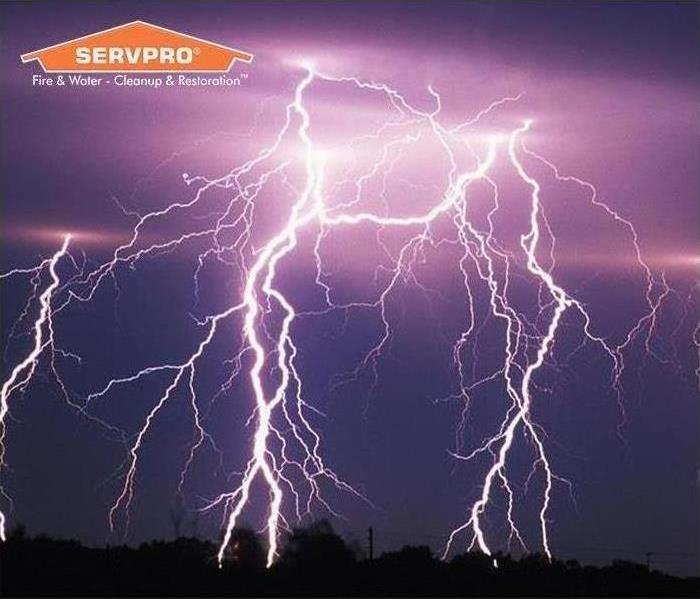 When Lightning strikes!
When Lightning strikes!
During thunderstorms, many of us like to sit and watch the bright flashes of lightning. It can be peaceful just to watch and listen as lightning and thunder strikes with the smooth sound of rain in the background. Since we are in thunderstorm season, let's learn about lightning!
The National Geographic defines lightning as an electrical discharge caused by imbalances between storm clouds and the ground, or within the clouds themselves. Most of the time, lightning occurs within the clouds.
Interesting facts you might not know about lightning:
- Lightning creates heat hotter than the sun – Experts believe that lightning can be as hot as 50,000 degrees Fahrenheit.
- Lightning can strike the same place more than once – Tall buildings or areas with conducive topography can see numerous lightning strikes. For example, the Empire State Building has been reportedly struck by lightning around 23 times per year.
- Lightning strikes multiple places at once – A single lightning bolt can strike more than one place at the same time. A videographer from Chicago once recorded a single lightning strike hitting the Willis Tower, Trump Tower and the John Hancock Building, three of city’s tallest buildings.
- Lighting can be up to 90 miles long – Martin Uman, lightning researcher, detected lightning channels as long as 90 miles.
- Florida experiences more lightning than any other state – Out of the top 15 counties in the United States with the most lightning strikes in 2018, 14 were in Florida.
- Venezuela experiences more lightning more than anywhere – Lake Maracaibo holds the record for “highest concentration of lightning,” according to The Guinness Book of World Records.
- More than 1 billion lightning strikes hit earth annually – The planet is hit by lightning an average of 1.4 billion times per year. If each of those strikes hit a person, humanity would come to an end in five years.
- Thunder does not exist without lightning – Thunder is the sound of lightning, it is the noise created as air expands and contracts rapidly in the lightning’s resonating tube.
- A lightning bolt can have up to a billion volts of electricity – This is about the same amount of power as 79.4 million car batteries.
- Benjamin Franklin came up with lightning protection – Franklin came up with the idea of securing lightning rods to the tops of buildings to protect structures from the impact of lightning.
For more interesting facts about lightning, go to The National Geographic and BestLife.
Electrical Safety During the Holidays
11/18/2019 (Permalink)
As a trusted leader in the restoration industry, SERVPRO of Carleton/Maybee has highly trained technicians that are dedicated to responding faster to any size disaster. We provide 24-hour emergency service and have the training and expertise to handle your restoration and cleaning needs.
As the holiday season is upon us, it is important to remember a few tips to maintain electrical safety during the most wonderful time of the year. Below are a few tips to keep in mind.
- Inspect all of your holiday lights. To prevent accidental fires, throw out any strands of lights that have frayed cords. Also, replace any broken or cracked bulbs.
- Use only UL-Listed lights and extension cords.
- Do not overload electrical sockets, extension cords, or power strips.
- It is never a good idea to plug an extension cord into a power strip.
- When hanging electrical decorations and lights, it is best to use a wooden or fiberglass ladder rather than a metal one for your own safety.
- Always turn off holiday lights before leaving the house or going to bed.
Fire Prevention Tips
11/18/2019 (Permalink)
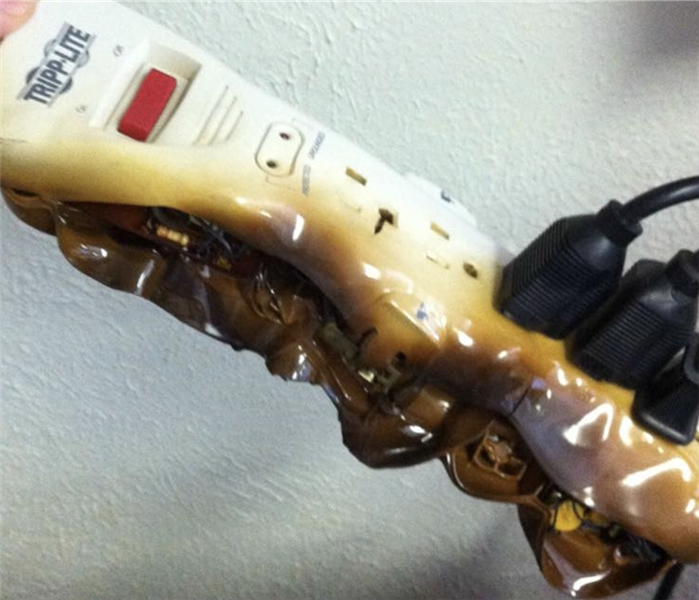 Burned power strip
Burned power strip
SERVPRO of Carleton/Maybee is dedicated to educating our communities on Fire Prevention and Safety tips.
- Keep all potential sources of fuel like paper, clothing, bedding or rugs at least three feet away from space heaters, stoves, or fireplaces.
- Portable heaters and fireplaces should never be left unattended. Turn off space heaters and make sure any embers in the fireplace are extinguished before going to bed or leaving home.
- If you must use a space heater, place it on a level, hard and nonflammable surface (such as a ceramic tile floor), not on rugs or carpets or near bedding or drapes. Keep children and pets away from space heaters.
- When buying a space heater, look for models that shut off automatically if the heater falls over as another safety measure.
- Never use a cooking range or oven to heat your home.
- Keep the fire in your fireplace by using a glass or metal fire screen large enough to catch sparks and rolling logs.
- Have wood and coal stoves, fireplaces, chimneys, and furnaces professionally inspected and cleaned once a year.
- Never plug space heaters into power strips.
Not Every Hero Wears a Cape
10/2/2019 (Permalink)
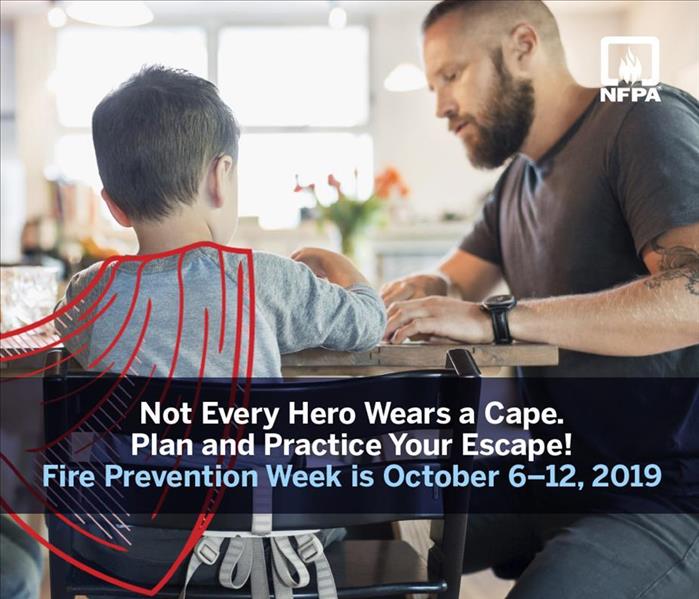 Not Every Hero Wears a Cape
Not Every Hero Wears a Cape
National Fire Prevention Week is October 6-12th, 2019. Here at SERVPRO of Carleton/Maybee we strive to help our communities be prepared in the event of a fire. We honor our local Fire Departments and pass out fire prevention materials to local schools and libraries. Here are some tips for fire escape and planning:
Home Fire Escape Planning and Practice
Home fire escape planning and drills are an essential part of fire safety. A home fire escape plan needs to be developed and practiced before a fire strikes.
• Home fire escape planning should include the following:
• Drawing a map of each level of the home, showing all doors and windows
• Going to each room and pointing to the two ways out
• Making sure someone will help children, older adults, and people with disabilities wake up and get out
• Teaching children how to escape on their own in case you cannot help them
• Establishing a meeting place outside and away from the home where everyone can meet after exiting
• Having properly installed and maintained smoke alarms
• Home fire escape practice should include the following:
• Pushing the smoke alarm button to start the drill
• Practicing what to do in case there is smoke: Get low and go. Get out fast.
• Practicing using different ways out and closing doors behind you as you leave
• Never going back for people, pets, or things
• Going to your outdoor meeting place
• Calling 9-1-1 or the local emergency number from a cell phone or a neighbor’s phone Smoke Alarms
• Smoke alarms detect and alert people to a fire in the early stages. Smoke alarms can mean the difference between life and death in a fire.
• Working smoke alarms cut the risk of dying in a home fire in half.
• Install smoke alarms in every sleeping room, outside each separate sleeping area, and on every level of the home, including the basement.
• Test smoke alarms at least once a month using the test button.
• Make sure everyone in the home understands the sound of the smoke alarm and knows how to respond. Cooking
• Cooking is the leading cause of home fires and home fire injuries. Thanksgiving is the leading day for fires involving cooking equipment.
• The leading cause of fires in the kitchen is unattended cooking.
• Stay in the kitchen when you are frying, boiling, grilling, or broiling food.
• If you are simmering, baking, or roasting food, check it regularly and stay in the home.
• Keep anything that can catch fire away from your stovetop. Heating
• Heating equipment is one of the leading causes of home fires during the winter months.
• Space heaters are the type of equipment most often involved in home heating equipment fires.
• All heaters need space. Keep anything that can burn at least 3 feet (1 meter) away from heating equipment.
• Have a 3-foot (1-meter) “kid-free zone” around open fires and space heaters.
• Purchase and use only portable space heaters listed by a qualified testing laboratory.
• Have a qualified professional install heating equipment.
• Maintain heating equipment and chimneys by having them cleaned and inspected by a qualified professional at least once a year.
 When the flames and smoke are gone, call SERVPRO of Carleton/Maybee to help return your home to it’s preloss condition.
When the flames and smoke are gone, call SERVPRO of Carleton/Maybee to help return your home to it’s preloss condition.





 24/7 Emergency Service
24/7 Emergency Service

